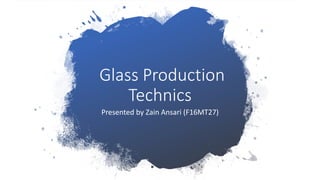
Glass production techniques
- 1. Glass Production Technics Presented by Zain Ansari (F16MT27)
- 2. Glass Production Techniques An amorphous, inorganic substance made by fusing silica (silicon dioxide) with a basic oxide; generally transparent but often translucent or opaque. Its characteristic properties are its hardness and rigidity at ordinary temperatures, its capacity for plastic working at elevated temperatures, and its resistance to weathering and to most chemicals except hydrofluoric acid. Used for both utilitarian and decorative purposes, it can be formed into various shapes, colored or decorated. Glass originated as a glaze in Mesopotamia in about 3500 BCE and the first objects made wholly of glass date to about 2500 BC.
- 3. Glass-making Techniques and Other Glass Terms Virtually all the techniques of glass-making in use today were known in antiquity. The tools have not changed essentially since the discovery of glass-blowing, although on technical level furnaces, chemistry and mass-production methods have been improved. Most of the advances in glass manufacture are the result of the industrial revolution; mechanical pressing, acid- etching and sand-blasting are techniques that have evolved only in the last two hundred years.
- 4. Core-Forming • the earliest method of making glass vessels is known as core-forming. Small containers were produced by trailing molten glass over a shaped, clay core fashioned on the end of a metal rod. Upon completion, the rod was removed, the vessel annealed (gradually cooled), and the clay core scraped out. The Erimtan Collection contains only one example of a core-formed vessel. It represents one of the last types made by using the technique.
- 5. casting This process involved the shaping of molten glass in a closed mould or over an open former. The earliest use of casting is found in the production of mosaic glass vessels during the Late Bronze Age. They were made by fusing together thin slices of coloured glass made from canes. After casting, the vessels were allowed to cool, and then they were usually cut and ground into their final form.
- 6. Blowing The combination of the blow-pipe and the knowledge of inflation revolutionized the glass industry, enabling craftsmen to make vessels more quickly, at less expense and in a greater variety of shapes.
- 7. Mould-blowing • This technique developed from the invention of glass-blowing, probably in the first quarter of the first century AD. It allowed the glass-maker to replicate designs and shapes at will, using a pre-made clay, metal or wooden mould.
- 8. Pattern-moulding This was a method in which a gather of glass was partially formed in a mould. The pattern thus created was then expanded and usually spiral-twisted during the re-inflation of the vessel.
- 9. • Tralling The application of glass threads, often in a contrasting colour, gave added interest to free-blown glass vessels • Cutting Cutting as a type of decoration was a separate operation carried out when the vessel was cold. The Romans distinguished clearly between the glass- maker and the glass-cutter, the former being called a vitrearius and the latter a diatretarius. While the glass-blower was principally involved in the manipulation of hot glass, the glass-cutter employed skills that were more closely related to those of the gem-cutter.
- 10. Fire-polishing The re-introduction of a vessel into the furnace in order to soften and thus smooth out any irregularities on the surface of the glass. Marvering Rolling softened glass over a flat surface, usually in order to smooth an added trail decoration into the side of the vesse
- 11. • Pontil A metal rod that enabled the glass-maker to hold and manipulate an object while working on it. After blowing, the pontil was attached to the bottom of a vessel while the rim, handle(s) and other decorative elements were added. • Kick A depression in the bottom of a vessel, usually caused by pressure exerted in the application of the pontil.
- 12. • Weathering:- Over time the composition of glass can deteriorate, creating a chemical deposit that often flakes off to leave a pitted and iridescent surface. This not only obscures the original colour and transparency of the glass but can also destroy the decorative details and, in extreme cases, the vessel itself.
- 13. Thank You See you next time
